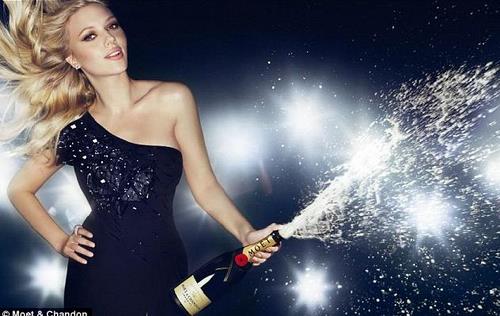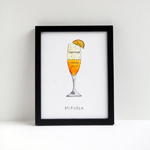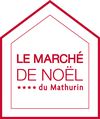 Alors que les fêtes de fin d’année approchent, j’ai le souhait de vous dire quelque mots sur nouveau Coup de Cœur gastronomique : un breuvage issu de 324 crus produits par 17 terroirs s’étendant sur 32 341 hectares. Il s’agit du champagne. On dit de lui « qu’il faut l’aimer rarement pour l’aimer beaucoup ». Pour ma part, je crois bien qu’il est fort aimable tout le temps. Parfois décapant aussi. Combien de vérités cachées remontent à sa surface en petites bulles dont le son ravissait le grand poète Max Jacob : « Le champagne fait le même bruit, dans son verre, que la mer sur le sable ». Il y a déjà longtemps, après les bonnes trouvailles du moine Don Pérignon (assemblage des raisins, bouchon en liège, bouteille en verre renforcé …), le champagne acquiert un rayonnement international. Chez les anglais pour commencer, dans le reste du monde, ensuite. Notamment grâce à Florens-Louis Heidsieck ou Claude Moët, Perrier ou Bollinger. De même, certaines femmes magnifièrent, avec bonheur, l’œuvre de leur mari. C’est le cas de Mme Clicquot, surnommée « la Grande Dame de Champagne ». Le champagne, décrit par Talleyrand comme le vin de la civilisation était, aussi, pour Honoré de Balzac, le symbole de l’amitié. Mais, tant de bonnes choses coûtent cher. En 2008, l’hectare de vigne se négociait, en moyenne, autour du million d’euros. Surtout pour les rares breuvages qui bénéficient de titres d’excellence. Sur l’ensemble des Crus de Champagne, seuls 17 d’entre eux ont, ainsi, l’appellation Grand Cru et 43 celle de Premier Cru. Enfin, pour les accros, je signale que la récolte 2009 s’annonce très prometteuse. Son potentiel d’alcool sera supérieur à 10% en moyenne avec une bonne acidité autour de 7,5 H2SO4g / litre. Les vins pourront être tirés dès le 1er janvier 2010 dans la limite de 8 000 kg / ha. Pas très poétique tout cela ? Mais, que voulez-vous, produire et vendre du champagne est un art polymorphe. S’y mêlent tradition, terroir, savoir faire, météo, chimie, quotas, technologie, big business et un chaleureux tchin-tchin de moi-même pour m’éclipser élégamment de mon sujet !
Alors que les fêtes de fin d’année approchent, j’ai le souhait de vous dire quelque mots sur nouveau Coup de Cœur gastronomique : un breuvage issu de 324 crus produits par 17 terroirs s’étendant sur 32 341 hectares. Il s’agit du champagne. On dit de lui « qu’il faut l’aimer rarement pour l’aimer beaucoup ». Pour ma part, je crois bien qu’il est fort aimable tout le temps. Parfois décapant aussi. Combien de vérités cachées remontent à sa surface en petites bulles dont le son ravissait le grand poète Max Jacob : « Le champagne fait le même bruit, dans son verre, que la mer sur le sable ». Il y a déjà longtemps, après les bonnes trouvailles du moine Don Pérignon (assemblage des raisins, bouchon en liège, bouteille en verre renforcé …), le champagne acquiert un rayonnement international. Chez les anglais pour commencer, dans le reste du monde, ensuite. Notamment grâce à Florens-Louis Heidsieck ou Claude Moët, Perrier ou Bollinger. De même, certaines femmes magnifièrent, avec bonheur, l’œuvre de leur mari. C’est le cas de Mme Clicquot, surnommée « la Grande Dame de Champagne ». Le champagne, décrit par Talleyrand comme le vin de la civilisation était, aussi, pour Honoré de Balzac, le symbole de l’amitié. Mais, tant de bonnes choses coûtent cher. En 2008, l’hectare de vigne se négociait, en moyenne, autour du million d’euros. Surtout pour les rares breuvages qui bénéficient de titres d’excellence. Sur l’ensemble des Crus de Champagne, seuls 17 d’entre eux ont, ainsi, l’appellation Grand Cru et 43 celle de Premier Cru. Enfin, pour les accros, je signale que la récolte 2009 s’annonce très prometteuse. Son potentiel d’alcool sera supérieur à 10% en moyenne avec une bonne acidité autour de 7,5 H2SO4g / litre. Les vins pourront être tirés dès le 1er janvier 2010 dans la limite de 8 000 kg / ha. Pas très poétique tout cela ? Mais, que voulez-vous, produire et vendre du champagne est un art polymorphe. S’y mêlent tradition, terroir, savoir faire, météo, chimie, quotas, technologie, big business et un chaleureux tchin-tchin de moi-même pour m’éclipser élégamment de mon sujet !
Ma préférence pour échanger quelques bulles se porte, comme le savent déjà certains lecteurs sur le Cristal Roederer rosé … en magnum !
Et pour prolonger l’effervescence, je vous recommande la lecture de ce blog.
Bubbles of truth
As the end of year celebrations approach, I would like to say a few words about another gastronomic gem: a drink with just 324 crus (classified types) produced in 17 areas in France stretching over 32,341 hectares. I am talking about champagne. It is said of this drink that « it should be enjoyed rarely to be enjoyed fully ». Personally, I think that it is enjoyable all the time, although occasionally dangerous too. How many hidden truths rise to its surface in the little bubbles, the sound of which delighted the great poet Max Jacob who said of it “A glass of champagne has the same sound as the sea on the sand” After the discoveries of the monk Don Pérignon (how to blend the grapes, using cork stoppers to close the bottles, using reinforced glass for the bottles themselves, etc.) champagne has long since acquired international fame, amongst the English to start with, and then in the rest of the world, particularly thanks to Florens-Louis Heidsieck and Claude Moët, Perrier and Bollinger. And certain ladies would also enhance the work of their husbands, such as Madame Clicquot, who was nicknamed ‘the Great Lady of Champagne’. Champagne, which Talleyrand described as the wine of civilization, was also, for Honoré de Balzac, the symbol of friendship. But, such a good thing is bound to be expensive. In 2008, a hectare of vines cost, on average, around a million Euros. Especially for the rare bottles which have titles of excellence. Of all the Champagne crus, only 17 are classified as Grand Cru and 43 as Premier Cru. Finally, for champagne enthusiasts, I can tell you that the 2009 harvest is very promising. Its alcohol potential will be above 10% on average with a good acidity of around 7.5 H2SO4g/litre. The wines could be bottled as of the 1st of January 2010 in the limit of 8000 kg/ha. Not very poetic at all? Well, what can I say? Producing and selling champagne is a multi-faceted art. It mixes tradition, that elusive French notion of ‘terroir’, know-how, weather, chemistry, quotas, technology, big business and a friendly ‘chin-chin’ from me as I make an elegant exit!
By the way, my favourite fizz, as some readers will already know, is pink Cristal Roederer champagne… a magnum if possible!
To prolong the pleasure, I recommend that you read this blog.
Didier MOINEL DELALANDE








3 commentaires pour “Bulles de vérité”